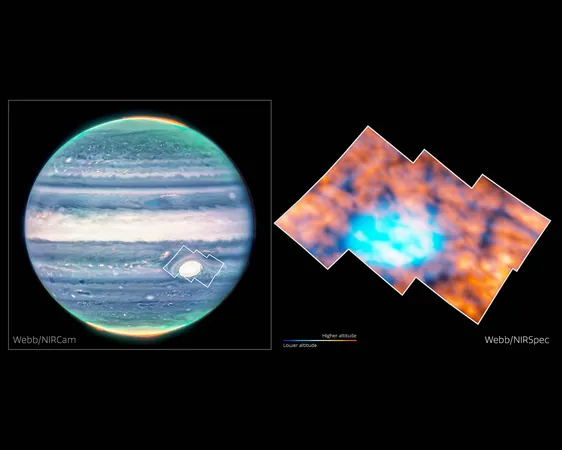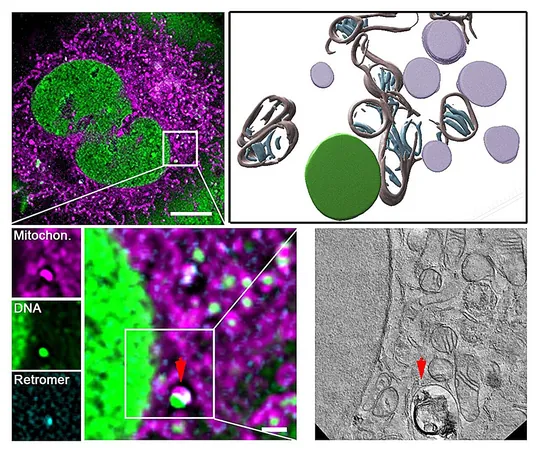
Astonishing 'Shapes' Unveiled Above Jupiter's Great Red Spot: A Glimpse into the Gas Giant's Mysterious Atmosphere!
2025-04-01
Author: Yu
Astonishing 'Shapes' Unveiled Above Jupiter's Great Red Spot: A Glimpse into the Gas Giant's Mysterious Atmosphere!
Jupiter, the largest planet in our solar system, is renowned for its striking size and swirling atmospheric features. Among its many wonders, the Great Red Spot stands out—a colossal storm that has been a defining characteristic of the planet for centuries. While much focus has been placed on the storm itself, recent observations have cast a new light on the area above this iconic vortex, revealing surprising features that enhance our understanding of Jupiter's atmosphere.
The recent study, spearheaded by Henrik Melin from the University of Leicester, utilized the cutting-edge James Webb Space Telescope (JWST) to delve into a region previously considered unremarkable. With its advanced infrared capabilities, the JWST captured details that had eluded scientists, showcasing unexpected structures and dynamics in Jupiter's upper atmosphere.
A New Perspective on Jupiter’s Upper Atmosphere
The findings from the Webb telescope were nothing short of revolutionary. Researchers discovered that, despite Jupiter receiving only about 4% of the sunlight that hits Earth due to its immense distance from the Sun, the upper atmosphere displayed intricate and active structures. By employing the Near-Infrared Spectrograph (NIRSpec), scientists identified dark arcs and bright points that were previously undocumented, reshaping our understanding of this extraterrestrial region.
Melin expressed surprise at the complexity of the area, stating, "We thought this region, perhaps naively, would be really boring. It is in fact just as interesting as the northern lights, if not more so. Jupiter never ceases to surprise."
The Role of Gravity Waves
The patterns observed are believed to be influenced by gravity waves—phenomena that ripple through the atmosphere, much like the way waves crash on a beach. These waves originate deep within Jupiter's turbulent lower atmosphere and can affect the upper layers, altering the energy balance. Interestingly, Earth experiences similar phenomena, although at a much lower intensity.
The research team aims to study these gravity waves further, tracking their migration through Jupiter’s upper atmosphere and their impact on the planet's energy dynamics. By monitoring these shifts over time, scientists hope to refine their models of atmospheric mechanics, ultimately enhancing our understanding of gas giants.
Why This Matters
Understanding the ionospheric phenomena on Jupiter is not just an exercise in planetary science; it offers valuable insights into Earth's own atmospheric dynamics. Tom Stallard, a professor of planetary astronomy at Northumbria University, noted that while Jupiter's magnetic field is significantly stronger than Earth's, there are substantial parallels in their ionospheric behavior. The data collected can provide knowledge applicable to our own planet, helping scientists understand the subtle processes occurring within Earth’s atmosphere.
Moreover, findings from these observations may prove crucial for the European Space Agency's Jupiter Icy Moons Explorer (JUICE), launched in April 2023. This mission aims to explore Jupiter and its icy satellites—Ganymede, Callisto, and Europa—while also measuring the planet's magnetic and atmospheric environment directly. Insights gained from the JWST observations could guide JUICE as it investigates the atmospheric structures that influence weather patterns on Jupiter.
A Call to the Cosmos
The latest images from the Webb telescope highlight a new layer of complexity that reshapes our understanding of ionospheric activities in the outer solar system. As scientists dive deeper into these atmospheric waves, they may unlock further mysteries of not only Jupiter but also gas giants beyond our solar system.
With every new revelation, we come closer to answering significant questions about the dynamics of planetary atmospheres. As excitement grows around these discoveries, the race to comprehend the untold stories swirling above the Great Red Spot continues.
Stay tuned, as the mysteries of Jupiter unravel, promising to elevate our understanding of giant planets across the cosmos!




 Brasil (PT)
Brasil (PT)
 Canada (EN)
Canada (EN)
 Chile (ES)
Chile (ES)
 Česko (CS)
Česko (CS)
 대한민국 (KO)
대한민국 (KO)
 España (ES)
España (ES)
 France (FR)
France (FR)
 Hong Kong (EN)
Hong Kong (EN)
 Italia (IT)
Italia (IT)
 日本 (JA)
日本 (JA)
 Magyarország (HU)
Magyarország (HU)
 Norge (NO)
Norge (NO)
 Polska (PL)
Polska (PL)
 Schweiz (DE)
Schweiz (DE)
 Singapore (EN)
Singapore (EN)
 Sverige (SV)
Sverige (SV)
 Suomi (FI)
Suomi (FI)
 Türkiye (TR)
Türkiye (TR)
 الإمارات العربية المتحدة (AR)
الإمارات العربية المتحدة (AR)